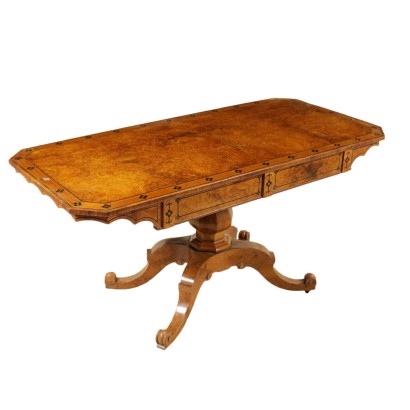Table Desk Maple Ebony Northern Europe Second Half of 1800s
Features
Age: 19th Century / 1801 - 1900
Origin: Northern Europe
Main essence: Maple , Brazilian Rosewood , Ebony , Various Wood Essences
Material: Walnut Burl Slab
Description
An elegant table, single multifaceted leg with serpentine carved feet. A pair of drawers on the band, shaped top. Threads and ebony inlays. Manufactured in Northern Europe, second half of the 19th century.
Product Condition:
The item shows signs of wear due to age. Any damage or loss is displayed as completely as possible in the pictures. It may require restoration and polishing.
Dimensions (cm):
Height: 77,5
Width: 160,5
Depth: 75
Additional Information
Age: 19th Century / 1801 - 1900
19th Century / 1801 - 1900 Main essence:
Maple
Hard, light wood used for inlays. It grows mainly in Austria, but it is widespread throughout the northern hemisphere, from Japan to North America, passing through China and Europe. It is one of the lightest woods ever, tending to white, it is similar to lime or birch wood. The briar is used in the production of ancient secretaires .
Brazilian Rosewood
It is a hard, light blond wood, but with strong red and pinkish veins, which is obtained from tropical trees similar to rosewood. Its veins are reminiscent of striped tulips, which is why it is called tulipwood in English-speaking areas. It is used for inlays, often combined with bois de violette. In the 1700s and 1800s it was highly appreciated and used in France and England for precious veneers. It gives off scent for decades if not centuries after curing.
Ebony
Without any doubt it is one of the most precious and appreciated essences ever. Very hard and resistant, it is pleasant to the touch thanks to its smoothness, it is a wood with a typical black color. Being very rare it was traded as a precious metal and frequently forged. Because of its hardness, it is very difficult to work, which is why the term cabinetmaker, which indicates the very skilled craftsman in fine carpentry works, derives from this very essence. In modern times, it was introduced by the Flemings and Germans and immediately enjoyed success with the French. The golden period for Ebony was the Baroque, especially in the Boulle style workings. In general it is widely used in inlays, but also for furniture upholstery, for contrasting effects alongside brass, bronze and tortoiseshell.
Various Wood Essences
Material: Walnut Burl Slab






























